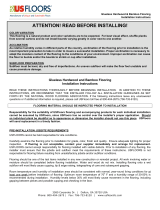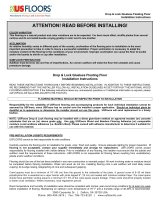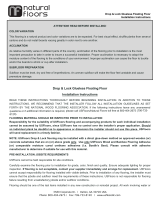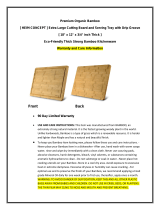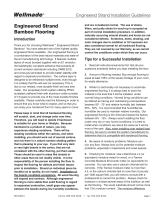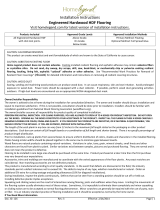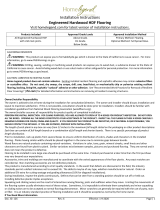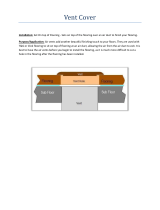Page is loading ...

NATURAL FLOORS INSTALLATION INSTRUCTIONS FOR TONGUE & GROOVE
HARDWOOD AND BAMBOO FLOORING
Enclosed you will find installation instructions for the following products:
• Solid and Engineered Tongue & Groove (T&G) Hardwood & Traditional Bamboo
• Solid and Engineered Tongue & Groove (T&G) Strand Woven Bamboo
USE THE GRID BELOW TO DETERMINE WHICH INSTALLATION METHOD IS ACCEPTABLE FOR EACH TYPE OF
PRODUCT
Type of Floor
Glue
Down
Nail
Staple
Float
Over
In-floor
Radiant
Heat
Special Instructions
Tongue & Groove
Engineered Hardwood and
Traditional Bamboo
Yes
Yes
Yes
Yes, if at
least 5”
wide
Yes
Oil finished floors require a coat of Woca
Refresher immediately after installation to
maintain warranty.
Tongue & Groove
Engineered Strand Woven
Bamboo
Yes
Yes
Yes
Yes, if at
least 5”
wide
Yes
Tongue & Groove Solid
Strand Woven Bamboo
Yes
Yes
No
No
Yes
For nail down installation, use only 18
gauge cleat nailer and cleat nails 1-1/4" to
1-1/2" with nailers tested by USFloors.
Tongue & Groove Solid
Hardwood & Traditional
Bamboo
Yes -
Bamboo
Only
Yes
Yes
No
Yes
Glue down installation is not recommended
for solid hardwood floors.
!
ATTENTION! READ BEFORE INSTALLING!
COLOR VARIATION
This flooring is a natural product and color variations are to be
expected. For best visual effect, shuffle planks from several
cartons and do not install boards varying greatly in color next to
one another.
ACCLIMATION
As relative humidity varies in different parts of the country,
acclimation of the flooring prior to installation is the most
important precaution to take in order to insure a successful
installation. Proper acclimation is necessary to adapt the
moisture content of the flooring to the conditions of your
environment. Improper acclimation can cause the floor to buckle
and/or the boards to shrink or cup after installation.
SUBFLOOR PREPARATION
Subfloor must be level, dry and free of imperfections. An uneven
subfloor will make the floor feel unstable and cause premature
damage.
READ THESE INSTRUCTIONS THOROUGHLY BEFORE
BEGINNING INSTALLATION. IN ADDITION TO THESE
INSTRUCTIONS, WE RECOMMEND THAT THE INSTALLER
FOLLOWS ALL INSTALLATION GUIDELINES AS SET FORTH BY
THE NATIONAL WOOD FLOORING ASSOCIATION.
FLOORING MATERIAL SHOULD BE INSPECTED PRIOR TO
INSTALLATION
Responsibility for the suitability of NATURAL FLOORS flooring
and accompanying products for each individual installation
cannot be assumed by NATURAL FLOORS, since NATURAL
FLOORS has no control over the installer's proper application.
Should an individual plank be doubtful as to appearance or
dimension the installer should not use this piece. NATURAL
FLOORS will send replacement in a timely fashion.
PRE-INSTALLATION JOBSITE REQUIREMENTS
NATURAL FLOORS cannot be held responsible for site conditions.
Carefully examine the flooring prior to installation for grade, color,
finish and quality. Ensure adequate lighting for proper inspection.
If flooring is not acceptable, contact your supplier immediately
and arrange for replacement.
NATURAL FLOORS cannot accept responsibility for flooring installed
with visible defects. Prior to installation of any flooring, the installer
must ensure that the jobsite and subfloor meet the requirements of
these instructions. NATURAL FLOORS is not responsible for flooring
failure resulting from unsatisfactory jobsite and/or subfloor conditions.
Flooring should be one of the last items installed in any new
construction or remodel project. All work involving water or moisture
should be completed before flooring installation. Water and wood do
not mix. Installing flooring onto a wet subfloor will most likely cause
cupping, tip & edge raising, telegraphing of core and subsequent
gapping.
Room temperature and humidity of installation area should be
consistent with normal, year-round living conditions for at least one
week before installation of flooring. Optimum room temperature of 70
o
F and a humidity range of 30-50% is recommended during installation.
Humidity levels below 30% will most likely cause movement in the
flooring, including gapping between pieces and possible cupping and
checking in the face.
Store the flooring in the installation area for 72 hours before installation
to allow flooring to adjust to room temperature. Do not store the boxes
of flooring directly on concrete. These floors need adequate
acclimation for moisture equalization prior to installation and should not
be installed from just-opened boxes. Shuffle the boards for best visual
mix of lengths and color.
PRE-INSTALLATION SUBFLOOR REQUIREMENTS
All Subfloors must be:
• Dry and will remain dry: Subfloor must remain dry year-
round. Moisture content of wood sub floors must not exceed
11%. Concrete must be tested for moisture content using
the Andydrous Calcium Chloride test method, a non-invasive
moisture meter, or a pin/probe moisture meter.
• Structurally sound
• Clean: Thoroughly swept and free of all debris (If being
glued down, subfloor must be free of wax, grease, paint,

2! !
sealers, & old adhesives etc., which can be removed by
sanding)
• Level: Flat to 3/16” per 10-foot radius
Wood subfloors must be dry and well secured. Nail or screw every 6”
along joists to avoid squeaking. If not level, sand down high spots and
fill low spots with a Portland Based leveling patch.
Concrete subfloors must be fully cured, at least 60 days old, and
should have minimum 6-mil polyfilm between concrete and ground.
Subfloor should be flat and level within 3/16” per 10’ radius. If
necessary grind high spots down and level low spots with a Portland
leveling compound.
All concrete should be tested for moisture prior to installation using the
Andydrous Calcium Chloride test method, a non-invasive moisture
meter, or a pin/probe meter. When using a Calcium Chloride Test, the
result must not exceed 3 lbs per 1000 sq. ft. in a 24 hour period.
A moisture test must be performed to ensure that the concrete slab is
dry. Remember, a concrete slab on/below grade that measures dry
today may become moist in the future due to rising groundwater.
Installing a moisture barrier now may be viewed as an insurance policy
against concrete becoming wet in the future. NATURAL FLOORS is
not responsible for site related moisture issues.
For additional protection, you may want to consider applying moisture
barrier compound system.
INSTALLATION TOOLS
For all installation methods:
• Tape measure
• Tapping block (trimmed piece of flooring)
• Pencil
• Pry bar or pull bar
• Chalk line
• Wood or plastic spacers (3/8”)
• Crosscut power saw
• 3M Blue Tape (DO NOT ADHERE TO OIL FINISHED
FLOORS)
For glue-down installation method, you’ll also need:
• Recommended flooring adhesive
• Trowel per flooring adhesive manufacturer’s
recommendations.
For nail-down installation of solid and engineered hardwood and
bamboo, and engineered strand woven bamboo, you will also need:
• Air stapler/nailer compatible with profile of the flooring
material
• 1 ½” – 2” nail, cleat, or staple that is compatible with the
profile of the flooring material
• Air compressor
For nail-down installation of solid strand woven bamboo, you will also
need:
• 18 gauge air cleat nailer compatible with profile of the
flooring material
• 1 ¼” – 1 ½” cleat nails
• Air compressor
Acceptable subfloor types:
• CDX Underlayment Grade Plywood (at least ½” thick)
• Underlayment grade particleboard (floating/glue-down only)
• OSB (at least ¾” thick)
• Concrete slab (floating/glue-down only)
• Existing wood floor
• Ceramic tile (floating/glue-down only)
• Resilient tile & sheet vinyl (floating/glue-down only)
STARTING YOUR INSTALLATION
Make sure subfloor is tested for moisture first and is properly
prepared.
Since natural flooring expands with any increase in moisture content,
always leave at least a 3/8” expansion space between flooring and all
walls and any other permanent vertical obstructions, (such as pipes
and cabinets). This space will be covered up once you reapply base
moldings around the room. Use wood or plastic spacers during
installation to maintain this 3/8’’ expansion space.
Work from several open boxes of flooring and “dry lay” the floor before
permanently laying the floor. This will allow you to select the varying
grains & colors and to arrange them in a harmonious pattern. It also
allows you the opportunity to select out very dark/light pieces for use in
hidden areas in order to create a more uniform floor. Remember, it is
the installers’ responsibility to determine the expectations of what the
finished floor will look like with the end user first and then to cull out
pieces that do not meet those expectations.
Begin installation next to an outside wall. This is usually the straightest
and best reference for establishing a straight working line. Establish
this line by measuring an equal distance from the wall at both ends and
snapping a chalk line. The distance you measure from the wall should
be the width of a plank plus about 3/8’’ for expansion space. You may
need to scribe cut the first row of planks to match the wall in order to
make a straight working line if the wall is out of straight.
You may want to dry lay a few rows, (no glue or nails), before starting
installation to confirm your layout decision and working line. When
laying flooring, stagger end joints from row to row by at least 8”. When
cutting the last plank in a row to fit, you can use the cut-off end to
begin the next row. If cut-off end is 8” in length or less, discard it and
instead cut a new plank at a random length and use it to start the next
row. Always begin each row from the same side of the room.
To draw planks together, always use a tapping block (a short piece of
flooring), as tapping the flooring itself will result in edge damage. For
best results, flip the tapping block upside down and use the groove
edge to tap the tongue edge of the plank being installed. Fit end joints
tightly together before tapping long edges together. When near a wall,
you can use a pry bar to pry close the side and end joints. Take care
not to damage edge of flooring. For glue down & floating applications,
use 3M
®
Blue Tape to hold any pieces which might have side bow and
need to be held straight & tight until the adhesive sets up. DO NOT
ADHERE TAPE OF ANY KIND TO OIL FINISHED FLOORS.
NAIL DOWN INSTALLATION FOR SOLID AND ENGINEERED
HARDWOOD AND BAMBOO AND ENGINEERED STRAND WOVEN
BAMBOO
REFER TO SEPARATE NAIL DOWN INSTALLATION
INSTRUCTIONS FOR SOLID STRAND WOVEN BAMBOO.
Make sure subfloor is tested for moisture content first and is properly
prepared. Use an air stapler/nailer compatible with profile of flooring
material (or) a stapler/nailer of your choice. Test on a sample to make
sure that stapling/nailing will not cause dimpling (localized raised
edges) in the finished floor. (Note: be sure to look at the face of the
installed flooring at a low angle from a distance to see if dimpling
is occurring as it is hard to see when directly above the floor.) If
dimpling does occur, STOP and adjust the stapler/nailer shoe and
angle/place of staple entry in order to avoid it. NATURAL FLOORS is
not responsible for dimpling.
For the first and second starting rows: lay first plank inside chalk line
with grooved edge toward wall. Install entire first row in the same
manner. Always leave at least a 3/8” expansion space between
flooring and all walls and vertical objects (such as pipes and cabinets).
Use wood or plastic spacers during installation to maintain this
expansion space. In order to affix the first rows, as it is difficult to get
the nail gun in place next to the wall, you may wish to set these rows in
mastic and glue them down rather than face nailing them and leaving
unsightly nail holes which must be filled with putty to match the wood
floor.
After gluing down these starting rows with manufacturer’s
recommended adhesive, set weight on top of these rows and allow
them to set before commencing stapling/nailing the additional rows, as
nailing the adjacent rows may cause the starting rows to subsequently
move. Make sure the starting rows are straight and drawn tight.
Subsequent rows: Lay by using floor nailer/stapler to blind-nail top
inside edge of tongue at a 45 degree angle. Nail each board every 8”
and within 2” of each end. Remember to stagger end joints from row
to row at least 8” apart and use a tapping block to fit boards together.
It may be necessary to face-nail in doorways or tight areas where the
nailer/stapler can’t fit, (or glue down in these areas and weight them
while the mastic sets). The last two rows will need to be face-nailed,
(or glued down), in the same manner as the first two rows.
Always make sure to visually check the installed floor as you go to
ensure that the stapling/nailing is not causing dimpling on the face.
(Note: be sure to look at the face of the installed flooring at a low
angle from a distance to see if dimpling is occurring as it is hard
to see when directly above the floor.) If dimpling does occur, STOP
and adjust the stapler/nailer shoe and angle/place of staple entry in
order to avoid it. NATURAL FLOORS is not responsible for dimpling.

3! !
NAIL DOWN INSTALLATION FOR SOLID STRAND WOVEN
BAMBOO
Make sure subfloor is tested for moisture content first and is
properly prepared.
IMPORTANT: Due the extreme hardness of solid strand woven
bamboo, particular care must be taken by the installer to ensure
that the appropriate nailer, proper cleats nails, and the correct PSI
settings are used to create a successful installation without
damaging the floor. Natural Floors takes no responsibility for
damage incurred to the floor as a result of improper installation.
This includes damage to the surface or tongue of the plank.
Natural Floors recommends using ONLY 18 gauge cleat nailer and
cleat nails 1-1/4” to 1-1/2” depending on whether the subfloor is
plywood or OSB. Failure to adhere to Natural Floors’
recommended cleat nailer and cleat nail guidelines may void the
warranty. Choice of appropriate power nailer and selection of
proper PSI settings are the sole responsibility of the home
owner/installer.
Natural Floors has successfully tested the power nailers listed
below. The PSI settings can range from 65-100 so it is important
to test nail a plank or planks to determine the correct PSI required
to install the floor without incurring damage. Check with the
power nailer manufacturer for specific PSI recommendations for
installing solid strand woven bamboo flooring.
Nailer
Adapter
Shoe
Manufacturer URL
Porta-Nailer 402
Hammerhead Floor
Nailer Kit
Yes
www.porta-nails.com
Powernail 50P and
50M
Yes
www.powernail.com
Bostitch MIIIFN –
Hardwood Flooring
Cleat Nailer
Yes
www.bostitch.com
Senco SHF10 &
SHF15 Manual
Hardwood Flooring
Cleat Nailer/SHF50
Pneumatic Hardwood
Flooring Cleat Nailer
N/A
www.senco.com
Porter-Cable
N/A
www.deltaportercable.com
Make sure subfloor is tested for moisture content first and is properly
prepared. Use an air nailer compatible with profile of flooring material
(or) a nailer of your choice. Test on a sample to make sure that nailing
will not cause dimpling (localized raised edges) in the finished floor or
damage to the tongue. (Note: be sure to look at the face of the
installed flooring at a low angle from a distance to see if dimpling
is occurring as it is hard to see when directly above the floor.) If
dimpling does occur, STOP and adjust the nailer shoe and angle/place
of cleat entry in order to avoid it. NATURAL FLOORS is not
responsible for dimpling or damage to the tongue.
For the first and second starting rows: lay first plank inside chalk line
with grooved edge toward wall. Install entire first row in the same
manner. Always leave at least a 3/8” expansion space between
flooring and all walls and vertical objects (such as pipes and cabinets).
Use wood or plastic spacers during installation to maintain this
expansion space. In order to affix the first rows, as it is difficult to get
the nail gun in place next to the wall, you will need to face nail them or
glue them to the floor. If face nailing, you must fill nail holes with wood
putty that matches the floor. You may wish to set these rows in mastic
and glue them down rather than face nailing them and leaving
unsightly nail holes which must be filled with putty to match the wood
floor.
After gluing down these starting rows with manufacturer’s
recommended adhesive, set weight on top of these rows and allow
them to set before commencing stapling/nailing the additional rows, as
nailing the adjacent rows may cause the starting rows to subsequently
move. Make sure the starting rows are straight and drawn tight.
Subsequent rows: Lay by using floor nailer/stapler to blind-nail top
inside edge of tongue at a 45 degree angle. Nail each board every 8”
and within 2” of each end. Remember to stagger end joints from row
to row at least 8” apart and use a tapping block to fit boards together.
It may be necessary to face-nail in doorways or tight areas where the
nailer can’t fit, (or glue down in these areas and weight them while the
mastic sets). The last two rows will need to be face-nailed, (or glued
down), in the same manner as the first two rows.
Always make sure to visually check the installed floor as you go to
ensure that the nailing is not causing dimpling on the face. (Note: be
sure to look at the face of the installed flooring at a low angle
from a distance to see if dimpling is occurring as it is hard to see
when directly above the floor.) If dimpling does occur, STOP and
adjust the stapler/nailer shoe and angle/place of staple entry in order to
avoid it. NATURAL FLOORS is not responsible for dimpling.
GLUE DOWN INSTALLATION
Make sure subfloor is tested for moisture content first and is
properly prepared.
On concrete subfloors, which are on or above grade (ground level),
always assume the worst even if they measure dry. We recommend
taking the following installation steps to ensure a trouble-free
installation:
! Testing and documenting moisture content prior to
installation
! Applying a sealer to the subfloor as needed.
Use flooring adhesive recommended by NATURAL FLOORS. Use of
another manufacturer’s adhesive may result in failure and void
warranty. Follow adhesive manufacturer’s instructions for proper trowel
size, minimum temperature, adhesive set time and open time before
beginning installation of flooring.
Once the spread adhesive has setup sufficiently per adhesive
manufacturer’s instructions, lay the first row of flooring with groove
facing the wall, and continue laying flooring. Always check your
working lines to be sure the floor is still aligned. Use tapping block to
fit planks together, but be careful not to let installed floor move on the
wet adhesive while you are working. Always leave at least a 3/8’’
expansion space between flooring and all walls and vertical objects
(such as pipes and cabinets). Use wood or plastic spacers during
installation to maintain this expansion space. Remember to stagger
end joints from row to row at least 8” apart.
When first section is finished, continue to spread adhesive and lay
flooring section by section until installation is complete. Use a damp
cloth to IMMEDIATELY REMOVE ANY ADHESIVE that gets on the
flooring surface. If adhesive cannot be completely removed with a
damp cloth, use the manufacturer’s recommended adhesive remover.
Never let flooring adhesive dry completely on the finished surface.
Walk each section of flooring in order to make sure it is well bonded to
the subfloor with the adhesive working time. Flooring planks on the
perimeter of the room may require weight on them until adhesive cures
enough to hold them down.
FLOATING INSTALLATION
Make sure subfloor is tested for moisture content first and is
properly prepared.
Floating installation method should only be used on engineered
floors measuring at least 5” in plank width.
When using Natural Cork CorkShield underlayment, no additional
moisture barrier is necessary. If using an alternative 1/8” thick pad and
installing below or on grade, polyfilm is required.
Laying polyfilm: Lay 6-mil polyfilm with seams overlapped 8”. Fasten
seams every 18-24” with duct tape. Run the outside edges of film up
perimeter of each wall 4”. Trim after flooring installation is complete.
Laying pad: Lay underlayment by butting edges, not overlapping.
Tape full length of the seam with duct tape. Leave ½” space between
pad and all walls and permanent vertical fixtures.
Installing the floor: start first row with groove toward wall. Glue end
joints of first row by applying a small but continuous bead tongue and
groove adhesive or PVAC glue to bottom side of the groove. Always
leave at least a 3/8” expansion space between flooring and all walls
and vertical objects such as pipes and cabinets. Use wood or plastic
spacers during installation to maintain this expansion space. Lay
subsequent rows of flooring by applying glue to side and end joints and
fitting planks together with a tapping block. Remember to stagger end
joints from row to row at least 8” apart.
Clean up any adhesive that is on the face of the floor by using a damp
rag – DO NOT allow adhesive to dry on the flooring face as it is difficult
to remove without damaging the finish.

4! !
In-floor Radiant Heat:
Use only recommended flooring adhesive over manufacturer’s
recommended plywood substrate.
• Turn the heat off for 24 hours before, during and 24 hours
after installation when installing over radiant heated
subfloors
• Failure to turn the heat off may result in shortened working
time of the adhesive.
• Floor temperature must not exceed 85°F (30°C).
• Failure to strictly follow adhesive manufacturer’s guidelines
may result in failure and void warranty.
Warning: Heating mats work very well under carpet, tile and
stone, however we do not recommend to have them placed
directly underneath a wood or bamboo floor. It is best to install
wood or bamboo flooring over embedded floor heating systems.
*This type of installation requires a specific construction of the
plywood subfloor and the installer for such must be familiar with
the NWFA recommendations.
NWFA (National Wood Flooring Association) can be reached at
800-422-4556 U.S, or 800-848-8824 Canada.
GENERAL RADIANT HEAT INSTALLATION GUIDELINES
• Radiant systems work effectively and with less trauma to the
wood floor if the heating process is gradual, based on small
incremental increases in relation to the outside temperature.
• Subfloors should have proper moisture tests according to
testing procedures outlined by the NWFA.
• Avoid penetration of the heating element, tubing
• Concrete subfloors should be fully cured.
• With water-heated radiant-heat systems, a pressure test
should be performed by a qualified plumber or the system
installer prior to beginning the installation of the wood
flooring.
• Radiant heat is dry heat and a humidification system may be
necessary to maintain wood flooring in its comfort zone.
AFTER INSTALLATION
• Flooring should be one of the last items installed in a project.
In order to protect the floors while other trades are finishing
their work prior to final cleanup and turnover to the owner,
use rosin paper and only use 3M
®
Blue Tape to hold the
rosin paper to the floor (other blue tapes may damage the
finish). Clean the floor thoroughly before laying the rosin
paper to ensure that no debris is trapped underneath. DO
NOT USE plastic film or other non-breathing coverings as
this can cause the floor to become damaged from humidity
buildups.
• Remove expansion spacers and reinstall base and/or
quarter round moldings to cover moldings to cover the
expansion space.
• Dust mop or vacuum your floor to remove any dirt or debris.
• It is suggested that you buff the floor with lamb’s wool pads
in order to remove any loose splinters, residues, foot prints,
etc.
• Install any transition pieces that may be needed (reducers,
T-moldings, nosing. etc.).
• If using glue-down method, do not allow foot traffic or heavy
furniture on floor for 24 hours
IMMEDIATELY AFTER INSTALLING OIL FINISHED FLOORS
• Vacuum the floor
• Clean the floor thoroughly with WOCA REFRESHER diluted
in water using:
1 CUP of WOCA REFRESHER per 5 QUARTS of warm water
• In a bucket, add 1 cup of WOCA REFRESHER to 5 quarts of
warm water.
• Damp mop only
• Make sure you rinse the cloth in another bucket of clean
water, as you do not want to reincorporate the dirt back onto
the floor.
• Let dry for 2 hours minimum before resuming traffic
• WOCA REFRESHER is available in natural (for natural and
colors other than white) and white (for white oiled floors).
• Perform normal daily or weekly cleaning by vacuuming or
dry mopping grit, dust etc.
Protection and Maintenance of Your Floor
Lasting beauty can be achieved through purchasing a quality floor
covering and providing proper on-going maintenance.
Fading: Natural floors contain organic pigments and are subject to
fading when exposed to direct sunlight. Where possible, use drapes or
other systems to protect your floor from excessive light.
Joints: Natural flooring reacts to the conditions in the environment.
Natural flooring plank systems expand and contract in response to
fluctuations in temperature and humidity. Controlling the environment,
maintaining an adequate temperature and relative humidity, will
minimize the visible effects of normal contraction and expansion.
Optimum recommended temperature is 70°F and relative humidity is
30% - 50%. In very dry climates, the use of a humidifier might be
necessary.
Photosensitivity: Natural Floors cork, bamboo, and hardwood floors
are photosensitive and will change color as they age or are exposed to
U.V. light. In some species (i.e. bamboo, cork), the natural
pigmentation will be lost and can develop a “bleached” appearance. In
many exotic hardwood species (i.e. Tigerwood), the flooring develops
a rich patina that will darken the appearance and enhance the natural
beauty of the material.
As this is a natural occurring phenomenon, accelerated with exposure
to U.V. light, it is not considered a material defect and is excluded from
coverage under the provisions of Natural Floors Limited .
Tips to Minimize Fading/Discoloration
• Avoid rubber-backed mats and rugs, as the backing may
discolor your floor.
• Change the location of your rugs periodically. Rearrange
more frequently if they are placed in front of doors and
windows.
• Use light filtering window treatments (i.e. blinds, drapes,
window film) that will help prevent sunlight exposure.
• Rearrange furniture seasonally to allow the flooring to
darken and age uniformly.
If completing a flooring extension or board replacement after the
original installation has been down for a period of time, the new
flooring will have a lighter appearance. As the material is exposed to
natural light, it should eventually blend in with the surrounding areas.
However, due to the age of your flooring, surface wear (and/or)
exposure to U.V. light, Natural Floors cannot guarantee replacement
flooring will be a 100% match to your existing product.
Remember that color variation is to be expected with natural products.
However, should an individual plank be doubtful as to appearance or
dimension the installer should not use this piece.
/
